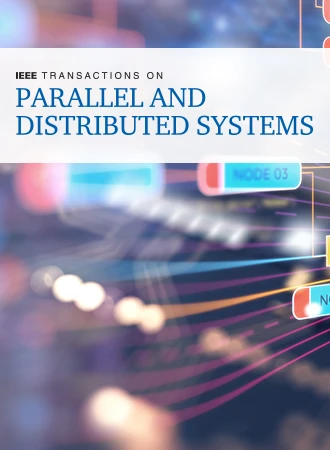XDGNN:基于解释引导子图展开的高效分布式GNN训练
IF 6
2区 计算机科学
Q1 COMPUTER SCIENCE, THEORY & METHODS
IEEE Transactions on Parallel and Distributed Systems
Pub Date : 2025-09-11
DOI:10.1109/TPDS.2025.3609152
引用次数: 0
摘要
图神经网络(GNN)是从图数据中学习结构信息的最新技术。然而,由于真实世界图的大小和gnn的消息传递架构,在大规模图上训练gnn是非常具有挑战性的。一种很有前途的扩展gnn的方法是跨多个加速器进行分布式训练,其中每个加速器都有一个适合内存的分区子图来并行训练模型。现有的分布式GNN训练方法需要在分区之间进行频繁且禁止的嵌入交换,导致大量的通信开销,限制了训练效率。为了解决这一挑战,我们提出了一种新的分布式GNN训练方法XDGNN,它消除了前向通信瓶颈,从而加快了训练速度。具体而言,我们设计了一种解释引导的子图扩展技术,该技术将解释人工智能(XAI)方法识别的重要结构纳入局部分区,从而减轻了图分区造成的信息丢失。然后,XDGNN通过并行训练模型,在前向阶段不通信节点嵌入,对这些自包含分区进行无通信的分布式训练。大量实验表明,与现有的分布式GNN训练方法相比,XDGNN在保持模型精度的同时显著提高了训练效率。本文章由计算机程序翻译,如有差异,请以英文原文为准。
XDGNN: Efficient Distributed GNN Training via Explanation-Guided Subgraph Expansion
Graph neural network (GNN) is a state-of-the-art technique for learning structural information from graph data. However, training GNNs on large-scale graphs is very challenging due to the size of real-world graphs and the message-passing architecture of GNNs. One promising approach for scaling GNNs is distributed training across multiple accelerators, where each accelerator holds a partitioned subgraph that fits in memory to train the model in parallel. Existing distributed GNN training methods require frequent and prohibitive embedding exchanges between partitions, leading to substantial communication overhead and limited the training efficiency. To address this challenge, we propose XDGNN, a novel distributed GNN training method that eliminates the forward communication bottleneck and thus accelerates training. Specifically, we design an explanation-guided subgraph expansion technique that incorporates important structures identified by eXplanation AI (XAI) methods into local partitions, mitigating information loss caused by graph partitioning. Then, XDGNN conducts communication-free distributed training on these self-contained partitions through training the model in parallel without communicating node embeddings in the forward phase. Extensive experiments demonstrate that XDGNN significantly improves training efficiency while maintaining the model accuracy compared with current distributed GNN training methods.
求助全文
通过发布文献求助,成功后即可免费获取论文全文。
去求助
来源期刊

IEEE Transactions on Parallel and Distributed Systems
工程技术-工程:电子与电气
CiteScore
11.00
自引率
9.40%
发文量
281
审稿时长
5.6 months
期刊介绍:
IEEE Transactions on Parallel and Distributed Systems (TPDS) is published monthly. It publishes a range of papers, comments on previously published papers, and survey articles that deal with the parallel and distributed systems research areas of current importance to our readers. Particular areas of interest include, but are not limited to:
a) Parallel and distributed algorithms, focusing on topics such as: models of computation; numerical, combinatorial, and data-intensive parallel algorithms, scalability of algorithms and data structures for parallel and distributed systems, communication and synchronization protocols, network algorithms, scheduling, and load balancing.
b) Applications of parallel and distributed computing, including computational and data-enabled science and engineering, big data applications, parallel crowd sourcing, large-scale social network analysis, management of big data, cloud and grid computing, scientific and biomedical applications, mobile computing, and cyber-physical systems.
c) Parallel and distributed architectures, including architectures for instruction-level and thread-level parallelism; design, analysis, implementation, fault resilience and performance measurements of multiple-processor systems; multicore processors, heterogeneous many-core systems; petascale and exascale systems designs; novel big data architectures; special purpose architectures, including graphics processors, signal processors, network processors, media accelerators, and other special purpose processors and accelerators; impact of technology on architecture; network and interconnect architectures; parallel I/O and storage systems; architecture of the memory hierarchy; power-efficient and green computing architectures; dependable architectures; and performance modeling and evaluation.
d) Parallel and distributed software, including parallel and multicore programming languages and compilers, runtime systems, operating systems, Internet computing and web services, resource management including green computing, middleware for grids, clouds, and data centers, libraries, performance modeling and evaluation, parallel programming paradigms, and programming environments and tools.
 求助内容:
求助内容: 应助结果提醒方式:
应助结果提醒方式:


